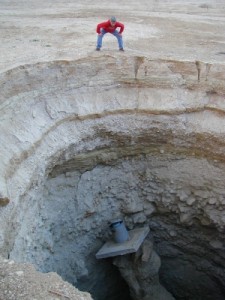The science – and silliness – of sinkholes
Every so often some new sinkhole makes the news.
This week the local hole worth knowing about opened up in West Quebec and closed Highway 148 between Luskville and Quyon.
That got me poking around the Internet on the subject of sinkholes in general.
Here’s a graphic from Canadian Geographic on how they form. That page included links to a few notorious sinkholes, like the one that shallowed cars at the National Corvette Museum.The Corvette Museum reportedly plans to keep their sinkhole, apparently it’s become a big draw.
Then there’s the big gulp of this watery sinkhole that just sort of eats trees.
A sinkhole in downtown Ottawa last February was linked to tunneling for the construction of a new light rail project.
But why stop there? Here’s a round up from ABC news of impressive sinkholes from around the world. And a Q&A from the UK’s Independent asking why we seem to be seeing so many of them all of a sudden.
Need more? How about memes on what caused a recent sinkhole in Malaysia (Godzilla, among others) including yet one more use for duct tape.
In case any fellow Luddites are wondering “Um, what’s a meme?” Wikipedia explains the concept (pronounced “meem”) thusly:
…an activity, concept, catchphrase or piece of media which spreads, often as mimicry, from person to person via the Internet.[1] Some notable examples include posting a photo of people lying down in public places (called “planking“) and uploading a short video of people dancing to the Harlem Shake.
Of course, some might say the Internet is just a giant mental sinkhole. But it can be fun sifting goodies out of the muck.
On a more sobering note, we may be in for more problems of this nature, considering the interplay of humans and their sprawl combined with more flooding and more frequent heavy downpours.
Tags: environment, nature, Ontario, Ottawa, Quebec, science, Sinkholes









I live right near Highway 148 in the Hull sector of Gatineau. Transports Quebec has message signs up along 148 notifying drivers of the situation at Luskville.
I remember the downtown Ottawa sinkhole too. It was right outside the University of Ottawa building where my department is located.
When I was a radio news reporter in southwestern Ontario about eight years ago, there was a sinkhole problem in a nearby rural community. It was not happening in the middle of roads, but rather on farmland. Conservation officials had determined that an underground aquifer was caving in. The size of the aquifer was huge. It extended from Perth County west of Stratford southwesterly to Windsor. Farmer’s were concerned because sinkholes were taking otherwise excellent land out of use.
There is a sinkhole in our family’s backyard. We filled it in decades ago- only required a few wheel-barrow loads then. Well it is back and would probably need a pickup load now. It sinks very slowly over decades. The house is 130+ years old. The hole may have been the outhouse pit. There are real sinkholes 1/4 mile away because limestone underlies the valley. Those are 50-100 feet across so maybe ours doesn’t empty fast. It would be interesting to do some seismic testing to learn more. There are several caves in that region too.
Looks like sinkholes should be good for creating jobs!
too bad one doesn’t open up under D.C.
that would create a few jobs too….